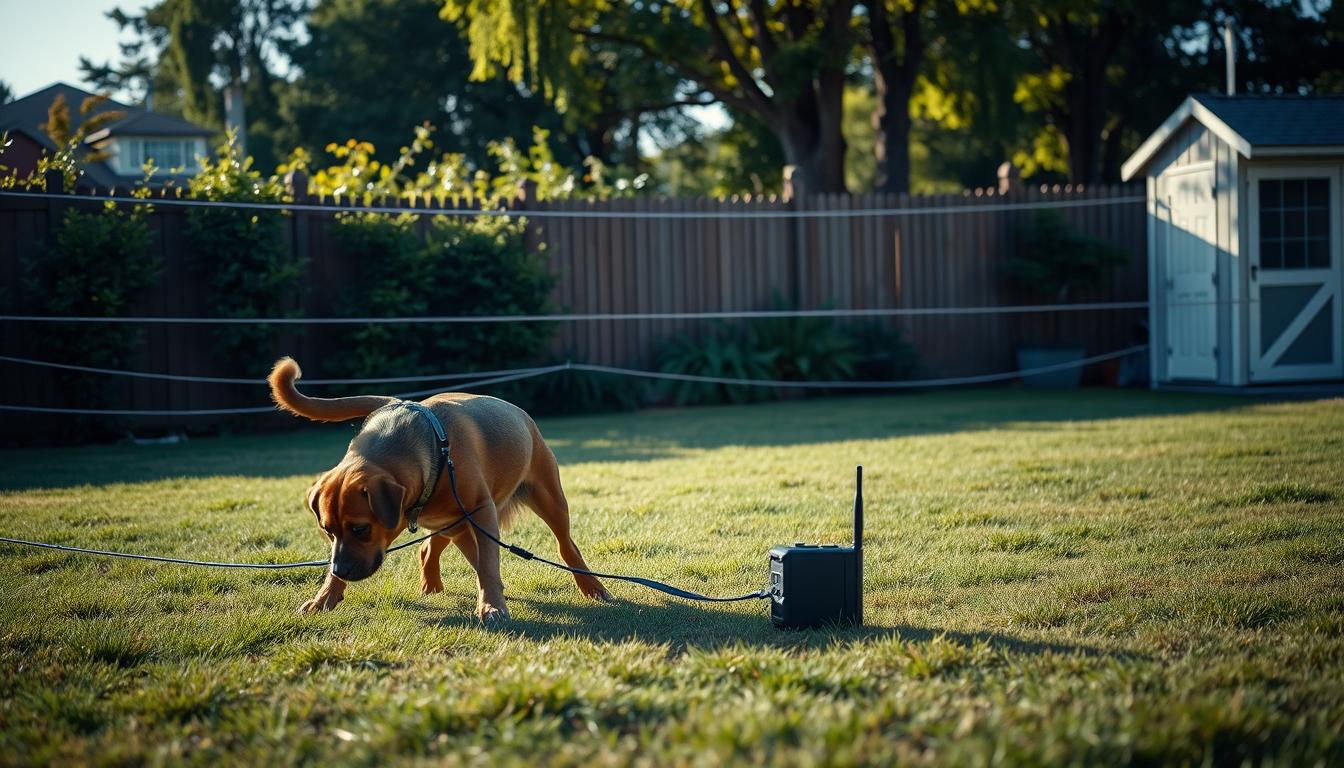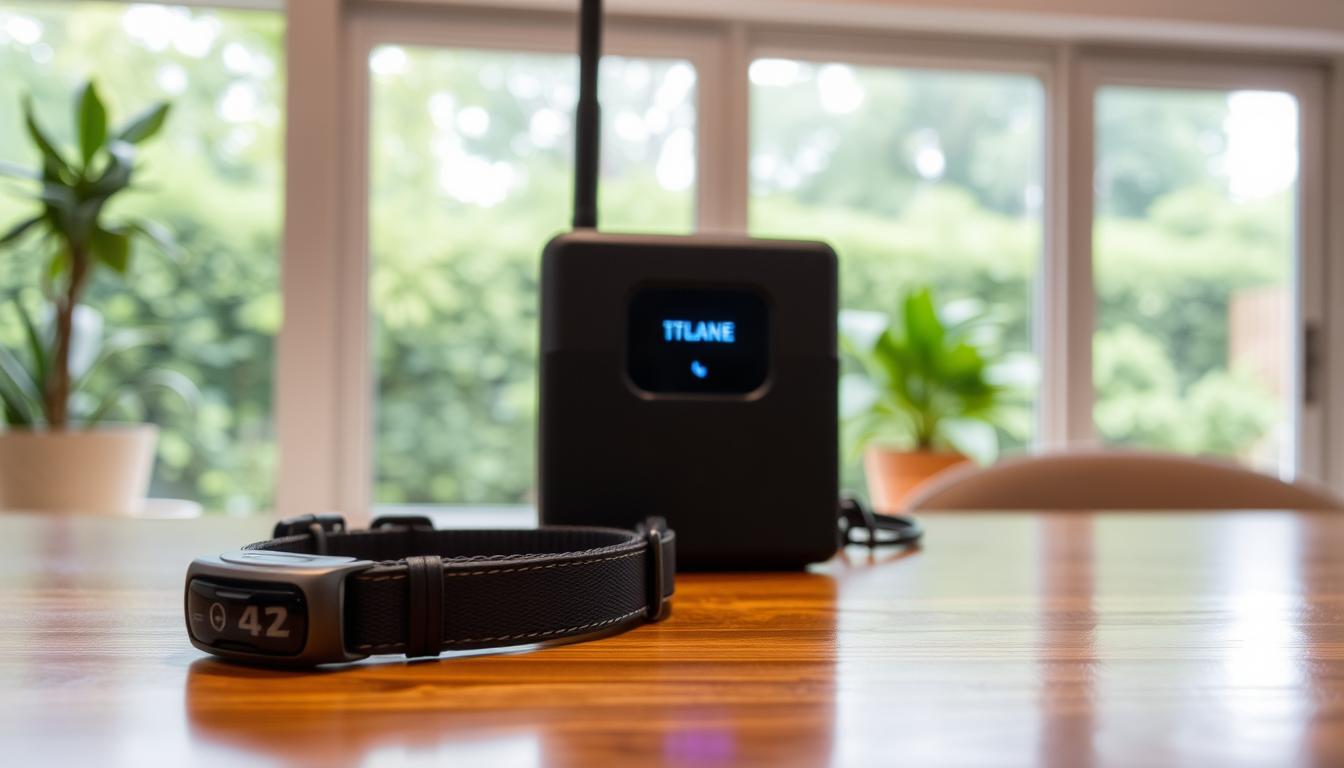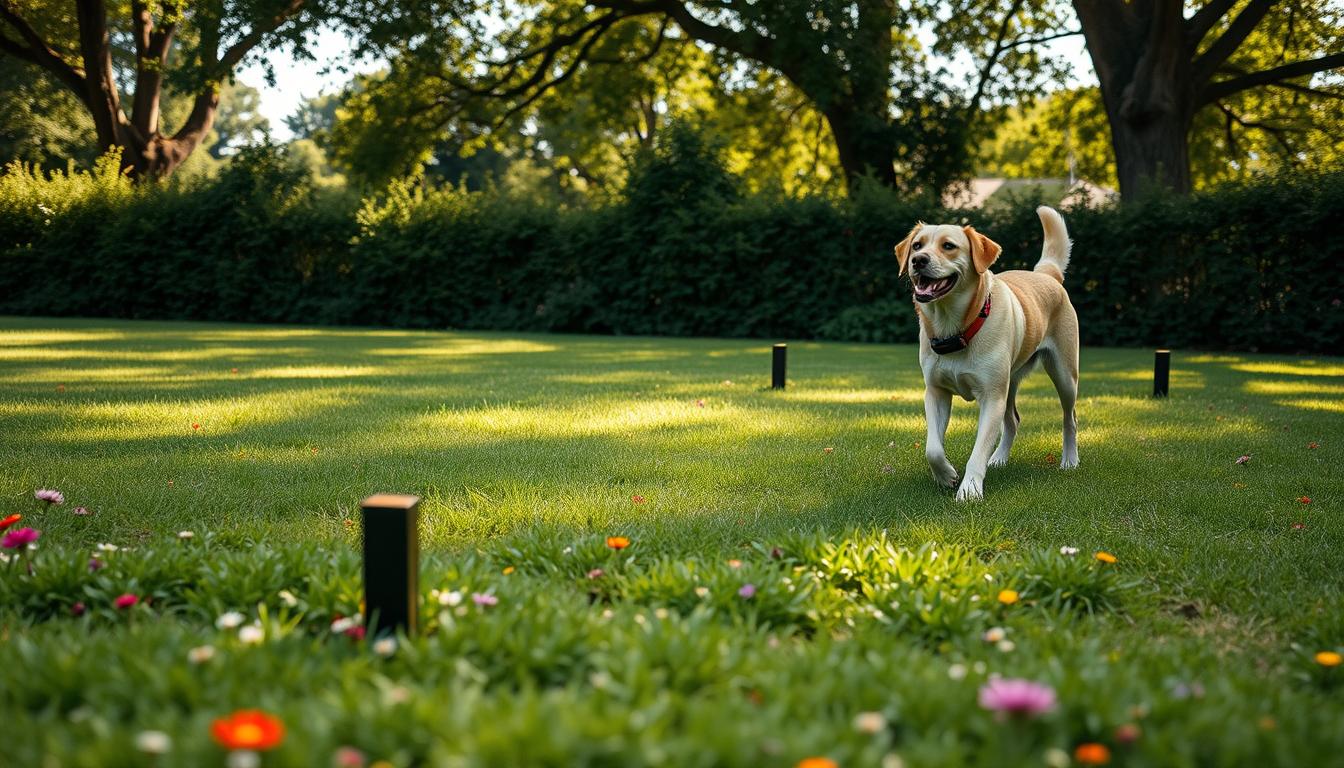You’re considering a wireless dog fence to keep your pet contained within your property, but are you aware of the potential pitfalls? Many pet owners make critical mistakes that compromise the effectiveness of their containment system.
Understanding the most common issues with wireless containment systems can help you avoid frustration and ensure your dog’s safety. Proper installation, collar fitting, and training protocols are just a few aspects to consider.
By being aware of these potential errors, you can maximize the effectiveness of your containment system and provide your dog with both safety and freedom to enjoy your property.
Key Takeaways
- Proper transmitter placement is crucial for effective containment.
- Correct collar fitting ensures your dog’s comfort and safety.
- Training protocols help your dog respect boundaries.
- Regular maintenance is necessary for optimal system performance.
- Avoiding common mistakes ensures a safe and effective containment system.
Understanding How Wireless Dog Fences Work
Wireless dog fences have revolutionized pet containment, offering a flexible and effective alternative to traditional fencing methods. These systems rely on GPS or radio signals to establish an invisible boundary, keeping your dog safe within a designated area.
Types of Wireless Fence Systems
There are several types of wireless dog fence systems available, each utilizing different technologies to create a containment area. These include radio frequency (RF) systems, GPS systems, and hybrid systems that combine both RF and GPS for enhanced reliability.
RF systems use a central transmitter to create a circular boundary around your home, while GPS systems rely on satellite coordinates to establish a boundary that can be more customizable in shape and size.
How the Boundary and Correction System Functions
The core components of any wireless fence system include a transmitter unit, a receiver collar worn by your dog, and a correction mechanism. When your dog approaches the boundary, the collar emits a warning tone or vibration, followed by a mild static correction if they continue towards or cross the boundary.
What to Expect from Your Wireless Fence
Understanding the capabilities and limitations of your wireless fence system is crucial. Most systems create circular boundaries with ranges between 1/2 acre to 3 acres, while GPS systems can cover larger areas. A training period of 2-4 weeks is required to help your dog understand the boundaries.
| System Type | Boundary Shape | Range | Training Period |
|---|---|---|---|
| RF Systems | Circular | 1/2 acre to 3 acres | 2-4 weeks |
| GPS Systems | Customizable | Larger areas | 2-4 weeks |
| Hybrid Systems | Customizable | Varies | 2-4 weeks |
By understanding how wireless dog fences work, you can better appreciate the technology and make informed decisions about their use.
Improper Placement of the Transmitter
The placement of the transmitter is crucial for the effective functioning of your wireless dog fence. The transmitter is the heart of your wireless fence system, and its placement significantly impacts the consistency and reliability of the containment boundary.
Ideal Locations for Your Transmitter
For optimal performance, position your transmitter centrally in your home on the ground floor, away from large appliances, metal filing cabinets, and other electronics that might cause interference with the signal. It’s also recommended to place the transmitter at least 3 feet off the ground and not directly on concrete floors, as these can absorb and weaken the signal strength throughout your yard.
Common Placement Errors
- Placing the transmitter against exterior walls or near large metal objects can create signal distortion.
- Mounting the transmitter too close to utility meters, HVAC equipment, or metal ductwork can create “dead zones” or inconsistent boundaries.
How to Test Signal Strength
To properly test signal strength, walk the perimeter with the collar at your dog’s neck height while listening for the warning beep. If you notice areas where the signal weakens or disappears, you’ll need to adjust the transmitter location or consider signal boosters.
Incorrect Boundary Setup
Setting up a wireless dog fence requires careful consideration of the boundary settings to ensure your dog’s safety. One of the most common reasons for escapes is incorrect boundary settings. If the range is too small or inconsistent, your dog may find ways to cross it.
Setting Appropriate Boundary Size
To avoid escapes, it’s crucial to set an appropriate boundary size. Recheck the boundary radius and increase the range if necessary. Using training flags temporarily can help your dog understand the containment area. Ensure the boundary is set well within your property to prevent overlaps with roads or public spaces.
- Setting your boundary too close to high-traffic areas like streets or driveways creates dangerous situations.
- Many homeowners make the mistake of setting the maximum boundary size without accounting for signal inconsistencies.
Dealing with Irregular Yard Shapes
Wireless systems typically create circular boundaries, which can be problematic for irregularly shaped yards. You’ll need to set the boundary to fit within your property lines, potentially losing usable yard space in certain areas. For yards with significant elevation changes, be aware that the boundary will follow a dome shape rather than respecting the contours of your land.
Avoiding Signal Interference Issues
Signal interference from neighboring properties using similar systems, power lines, or large metal structures can create boundary fluctuations. Regularly walk your property line to check for consistent signal strength. This will help you identify and address any issues before they become a problem.
By carefully setting up your wireless dog fence and being mindful of potential issues, you can create a safe and effective containment system for your dog.
Wireless Fence Mistakes: Poor Collar Fit and Maintenance
One of the most significant mistakes dog owners make with wireless dog fences is neglecting the collar’s fit and maintenance. A well-fitted collar is crucial for the effective functioning of the wireless fence system, as it ensures consistent corrections and boundary warnings.
Proper Collar Fitting Techniques
To ensure your dog’s safety and the effectiveness of the wireless fence, it’s essential to fit the collar correctly. The receiver should be positioned under your dog’s chin while they’re standing on all four feet. You should be able to fit only one finger between the contact points and your dog’s skin. If it’s looser, the collar may not function properly, leading to inconsistent corrections.
Adjusting the collar to fit snugly but comfortably around your dog’s neck is vital. Ensure the contact points make skin contact, especially on long-haired breeds. For dogs with thick fur, consider trimming a small patch of fur or using longer contact points designed for long-haired dogs.
When and How to Remove the Collar
Many owners forget to regularly rotate the collar position on their dog’s neck (every 1-2 hours) and remove it entirely at night. Failing to do so can lead to pressure necrosis, skin irritation, or painful “hot spots” that require veterinary attention. Removing the collar at night gives your dog’s skin a break, helping prevent these issues.
Preventing Skin Irritation and Sores
To prevent skin irritation, check for any signs of redness or discomfort whenever you put the receiver collar on your pet. Ensure the contact posts make firm contact with your pet’s skin. If necessary, shave an area under your dog’s neck about the size of a deck of playing cards to improve contact. Never attach a leash to the receiver collar, as this can damage the collar or cause injury to your dog’s neck.
By following these guidelines, you can ensure a proper fit and maintain your dog’s comfort and safety while using the wireless dog fence.
Battery and Power Issues
A weak or dead battery in your dog’s collar can compromise the entire wireless fencing system. Ensuring that the battery is always in good condition is crucial for the continuous operation of your wireless dog fence.
Signs of Low Battery Power
Neglecting to monitor battery life can lead to system failure, allowing your dog to escape. Most collar batteries last between 1-3 months, depending on usage and correction frequency. Signs that the battery is running low include inconsistent boundary warnings, decreased correction strength, and flashing indicator lights on the collar. Some models may also provide audible low battery warnings.
Proper Battery Maintenance
To avoid battery-related issues, it’s essential to establish a regular schedule for checking and replacing the battery based on the manufacturer’s recommendations. Extreme temperatures can significantly impact battery life, with cold weather being particularly detrimental. During winter, check the batteries more frequently and consider keeping spare batteries warm before installation.
Dealing with Power Failures
Power outages can be a significant vulnerability for wireless fence systems. To mitigate this, consider investing in a backup power supply for your transmitter, such as a UPS battery backup. Keeping spare collar batteries on hand is also crucial for continuous protection.
| Issue | Signs | Solution |
|---|---|---|
| Low Battery | Inconsistent warnings, decreased correction strength, flashing lights | Check and replace battery regularly |
| Power Outage | System failure | Use UPS battery backup for transmitter |
| Extreme Temperatures | Reduced battery efficiency | Check batteries frequently in extreme weather, keep spares warm |
By being proactive about battery maintenance and having contingency plans for power failures, you can ensure that your wireless dog fence remains effective and your dog stays safe.
Inadequate Dog Training Protocols
The success of a wireless dog fence largely depends on how well you train your dog to stay within the designated boundary. Without proper training, your dog may not understand the warning signals or the corrections, leading to potential escape or injury.
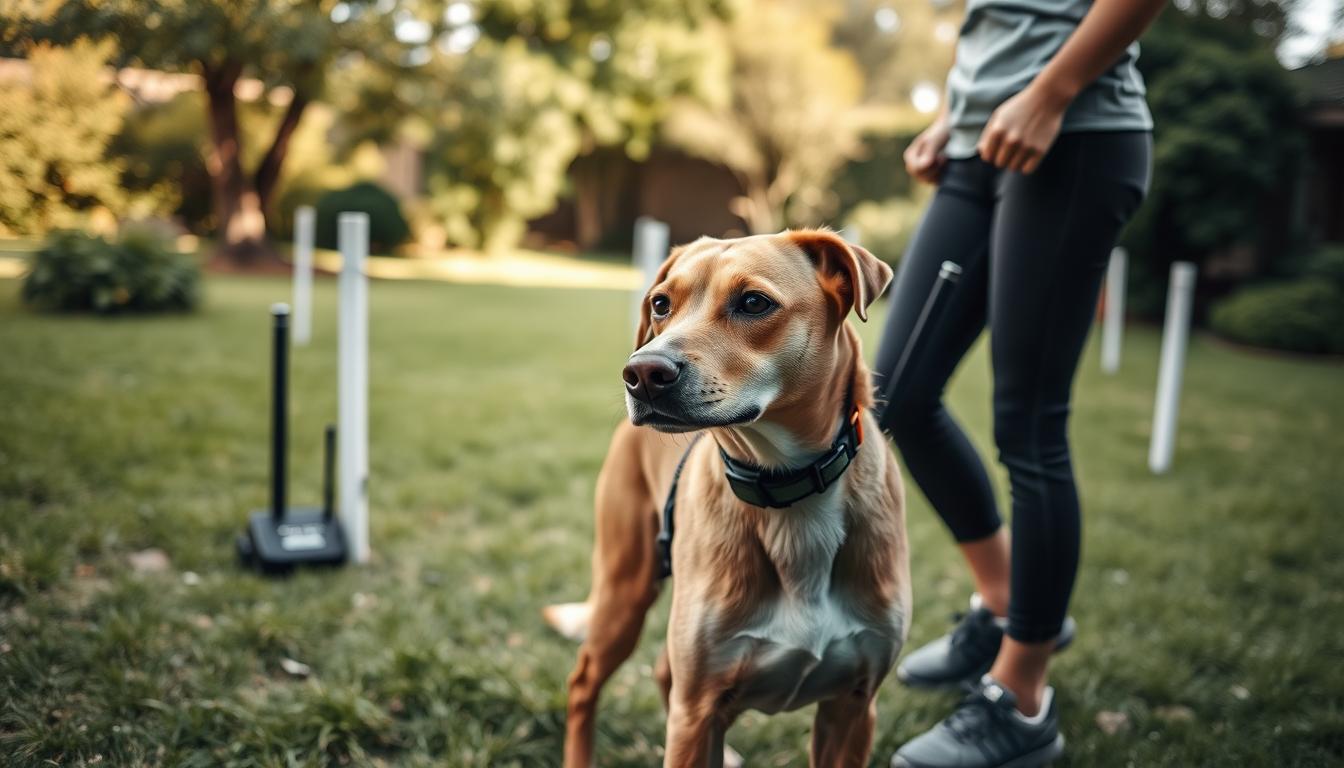
Essential Training Steps for New Systems
To start, it’s crucial to introduce your dog to the wireless dog fence system gradually. Begin with visual markers or boundary flags to help your dog recognize the boundary. This visual cue is essential for your dog to understand where the limit lies.
As you progress, use positive reinforcement by rewarding your dog for staying within the safe zone. This could be in the form of treats or praise, encouraging your dog to associate staying within the boundary with positive outcomes.
Training Duration Expectations
Training typically takes about 2-4 weeks, depending on your dog’s temperament and your consistency. It’s essential to commit to short, focused training sessions 3-4 times daily during the initial training period. Walking your dog around the entire boundary on a leash can help ensure they understand the system’s limits.
Using Positive Reinforcement Effectively
Positive reinforcement is a critical component of the training process. By praising and rewarding your dog when they respond correctly to warning tones, you create a positive association with respecting the boundary. This approach not only speeds up the learning process but also strengthens your bond with your dog.
Some common mistakes to avoid include rushing the training process, skipping the flag training phase, and failing to introduce the correction phase gradually. Consistency and patience are key to successful training. By dedicating time to proper training and using positive reinforcement, you can ensure your dog understands and respects the wireless dog fence boundary.
Ignoring Warning Signals from Your Dog
Ignoring your dog’s warning signals can lead to serious issues with your wireless dog fence. Your dog communicates system problems through subtle behavioral changes that many owners miss.
Behavioral Signs of System Problems
Dogs may exhibit increased reluctance to enter certain yard areas, unusual nervousness when wearing the collar, or hesitation during outdoor time, all of which can indicate boundary inconsistencies. It’s essential to recognize these warning signals to adjust the system accordingly.
- Reluctance to enter certain areas may signal boundary issues.
- Nervousness when wearing the collar could indicate discomfort or correction level issues.
- Hesitation during outdoor time might suggest the dog is testing the boundaries.
When Your Dog Tests Boundaries
When your dog begins testing boundaries by lingering at the edge of the containment area or watching for opportunities to dash through, it’s a critical warning sign that requires immediate retraining rather than punishment.
Addressing Fear or Anxiety Responses
Fear responses such as yelping, cowering, or refusing to go outside while wearing the collar indicate the correction level may be too high for your dog’s temperament. Adjusting to a lower setting and rebuilding confidence through positive reinforcement can help alleviate these issues.
By paying close attention to your dog’s behavior and adjusting the wireless dog fence system as needed, you can ensure a safe and effective containment solution.
Failing to Test the System Regularly
One of the most critical mistakes dog owners make is not regularly testing their wireless dog fence. Many owners set up their wireless dog fence system and never check it again, unaware that signal strength can fluctuate due to environmental changes, battery degradation, or equipment issues.
How to Properly Test Your Wireless Fence
To test your system effectively, take the collar into the yard and simulate your dog’s position. Hold the collar at the same height as your dog’s neck and walk towards the boundary. You should hear a beep or tick as you approach the edge. This confirms the receiver, batteries, and transmitter are working correctly.
Recommended Testing Schedule
A comprehensive testing schedule is crucial. Perform weekly quick checks of boundary consistency, monthly full perimeter walks with the collar, and seasonal thorough evaluations to account for environmental changes.
Troubleshooting Common Testing Issues
Common mistakes include misinterpreting the collar’s timeout feature as a system failure and not checking multiple points around the perimeter. Always exit the boundary area completely before retesting another section to ensure accurate results.
Environmental Factors Affecting Performance
Environmental conditions play a crucial role in determining how well your wireless dog fence operates. Various factors can influence the effectiveness of the system, and understanding these can help you maintain its performance.
Seasonal Changes and Weather Effects
Seasonal changes can significantly impact the performance of your wireless dog fence. For instance, dense summer foliage, fallen autumn leaves, winter snow accumulation, and spring flooding can all alter signal propagation and boundary consistency. Heavy precipitation, especially thunderstorms, can temporarily disrupt GPS-based systems by interfering with satellite signals.
- Keep an eye on your dog during severe weather events.
- Be aware that signal strength may vary with weather conditions.
Landscape Modifications Impact
Any modifications to your yard, such as adding metal garden structures, installing new fencing, or building additions to your home, can create signal interference zones. It’s essential to retest your system after making any property changes to ensure it continues to function correctly.
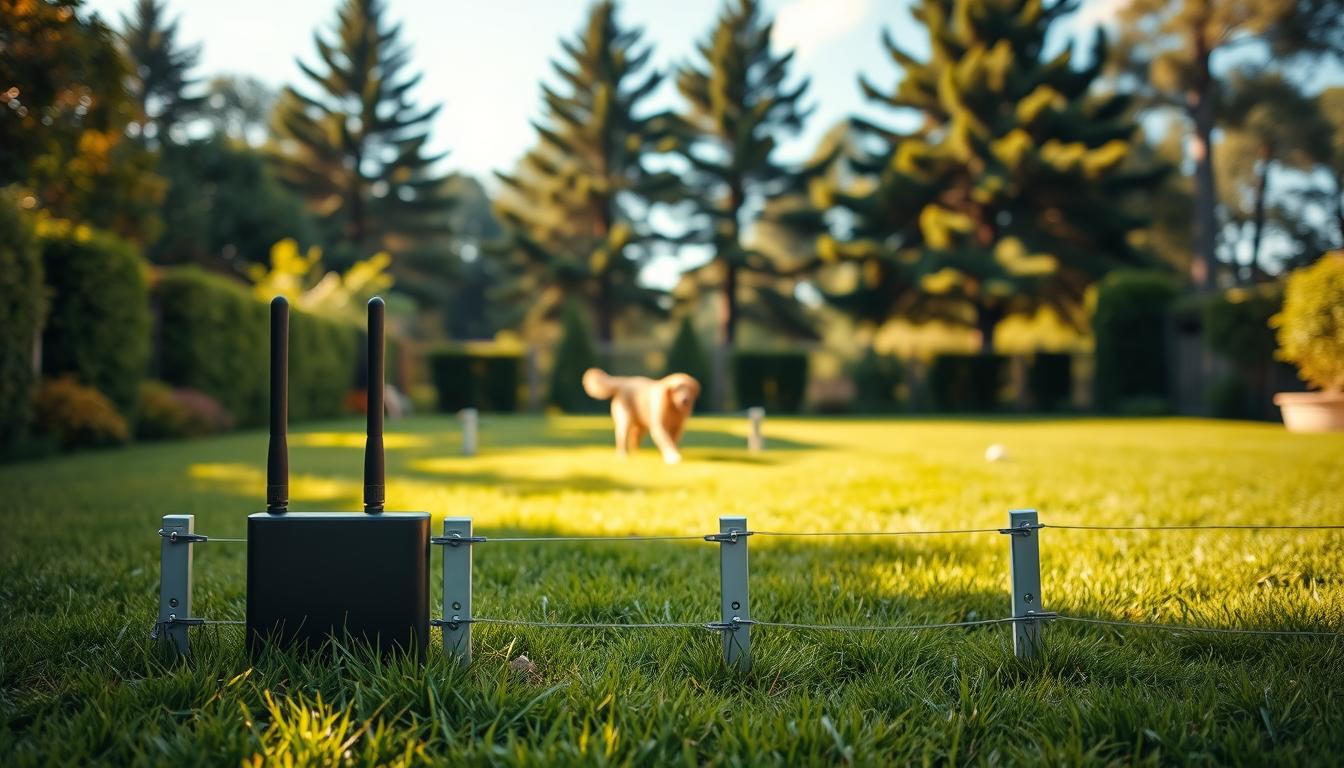
Dealing with Snow and Ice Challenges
Neither snow nor ice affects your dog’s fence directly, but they can impact your dog’s perception of the yard boundaries. When landmarks are covered by snow, your dog must relearn the boundaries. If your dog responds to the correction signals by backing up, there’s no issue. However, if your dog ignores the signals, you may need to troubleshoot your system.
| Environmental Factor | Impact on Wireless Dog Fence |
|---|---|
| Seasonal Changes | Alters signal propagation and boundary consistency |
| Landscape Modifications | Can create signal interference zones |
| Snow and Ice | Affects dog’s perception of yard boundaries |
By understanding and addressing these environmental factors, you can ensure your wireless dog fence continues to perform effectively, keeping your dog safe within your yard.
Common Fencing Issues with Multiple Dogs
Managing multiple dogs with a wireless dog fence requires careful consideration of several factors to avoid common pitfalls. When you have more than one dog, the complexity of the system increases, and several issues can arise that may not be immediately apparent.
Setting Up for Multiple Pets
To effectively use a wireless dog fence with multiple dogs, it’s essential to set up the system correctly. This includes ensuring that each dog’s collar is properly fitted and calibrated to the correct settings. Using the same correction level for all dogs, regardless of size, temperament, or sensitivity, is a common mistake. Each dog should have individually calibrated settings that account for their specific needs and response patterns.
Collar Interference Problems
Collar interference is another issue that can occur when multiple dogs wear wireless fence collars in close proximity. This can cause erratic corrections or false triggers. Some systems require collars to be programmed to different frequencies to prevent this issue. Regularly checking for interference and adjusting the collars as needed can help mitigate this problem.
Training Challenges with Multiple Dogs
Training multiple dogs to use a wireless fence system can be challenging, especially when considering pack dynamics. Many owners fail to account for the fact that one dog breaking the boundary can encourage others to follow. To avoid this, each dog must be trained individually before allowing them to play together in the contained area.
| Issue | Description | Solution |
|---|---|---|
| Collar Damage | One dog may damage another’s collar by mouthing or playing with it. | Regularly inspect all collars for damage. |
| Collar Interference | Multiple collars can cause erratic corrections or false triggers. | Program collars to different frequencies. |
| Training Challenges | One dog’s behavior can influence others. | Train each dog individually. |
To manage these challenges effectively, it’s crucial to be aware of the potential issues and take steps to mitigate them. By doing so, you can ensure a safe and effective wireless dog fence system for all your pets.
Overlooking System Limitations
Understanding the constraints of your wireless dog fence is vital for maintaining your dog’s safety and freedom. While these systems offer a convenient solution for pet containment, they are not without their limitations.
Understanding Range Restrictions
Many owners have unrealistic expectations about wireless fence range capabilities. Standard wireless systems typically offer a maximum radius of 90-180 feet from the transmitter. It’s essential to understand that the actual coverage can be affected by various factors, including terrain and interference sources.
Signal Consistency Challenges
Signal consistency is inherently limited in wireless systems, with boundaries that can fluctuate by 2-10 feet depending on terrain, weather conditions, and interference sources. This “fuzzy” boundary requires thorough training for dogs to understand.
When to Consider Alternative Containment Options
Wireless dog fence systems are not designed to contain dogs with strong prey drives, severe anxiety issues, or aggressive tendencies. For properties near busy roads or with determined escape artists, a wireless system may need to be supplemented with physical barriers in vulnerable areas.
| Limitation | Description | Solution |
|---|---|---|
| Range Restrictions | Limited coverage area | Understand transmitter range |
| Signal Consistency | Boundary fluctuations | Thorough dog training |
| Behavioral Issues | Dogs with strong prey drives or anxiety | Supplement with physical barriers |
By understanding the limitations of your wireless dog fence system, you can take necessary steps to ensure your dog’s safety and containment. Regularly assessing your system’s performance and adapting to its constraints will help you make the most out of your wireless dog fence.
Ensuring Long-Term Success with Your Wireless Dog Fence
Ensuring your wireless dog fence operates correctly is vital for the safety and well-being of your dog. To achieve long-term success, it’s essential to perform ongoing maintenance tasks.
Regular checks are necessary to keep your wireless dog fence functioning properly. This includes checking the battery, inspecting the transmitter, and testing the boundary to ensure consistent performance. Many owners overlook the importance of continued training reinforcement; occasional refresher sessions can help maintain boundary respect and prevent unwanted behaviors.
Creating a positive association with the containment area is also crucial. Engage in fun activities with your furry friend, provide interesting toys, and spend quality time in the yard to keep your dog happy and safe within the boundaries.
Seasonal adjustments may be necessary to maintain effective containment. For instance, consider adjusting correction levels during winter months when your dog wears thicker coats. It’s also vital to communicate with service providers, visitors, and family members about your wireless containment system to prevent accidental breaches.
By following these guidelines, you can ensure your wireless dog fence remains effective, keeping your dog safe and within safe boundaries.
FAQ
How do I know if my wireless dog fence is working correctly?
To verify that your system is functioning properly, check the signal strength and ensure the boundary is correctly set. You should also test the collar response to the warning and correction signals.
What are the ideal locations for placing the transmitter?
The transmitter should be placed in a central location, away from metal objects and other sources of interference. Ideally, it should be positioned at least three feet off the ground to maximize signal coverage.
How often should I test my wireless dog fence system?
You should test your system regularly, ideally once a month, to ensure it’s working correctly. Check the battery life, signal strength, and collar response during these tests.
Can I use my wireless dog fence with multiple dogs?
Yes, most wireless dog fence systems are compatible with multiple dogs. However, you may need to purchase additional collars and ensure that the system can support multiple pets.
How do I prevent skin irritation on my dog’s neck?
To prevent skin irritation, ensure the collar is fitted correctly and check your dog’s neck regularly for signs of irritation. You should also follow the manufacturer’s guidelines for collar maintenance.
What should I do if my dog is experiencing fear or anxiety responses to the correction signal?
If your dog exhibits fear or anxiety, adjust the correction level or consult with a professional dog trainer to help your dog become comfortable with the system.
How do seasonal changes affect my wireless dog fence system?
Seasonal changes, such as snow or heavy foliage, can impact signal strength and boundary effectiveness. You may need to adjust the system settings or transmitter location to maintain optimal performance.
Can I use a GPS fence instead of a wireless dog fence?
GPS fences offer an alternative containment solution, using satellite signals to define boundaries. However, they may require a subscription service and have different system requirements.

